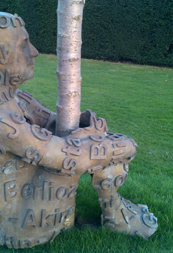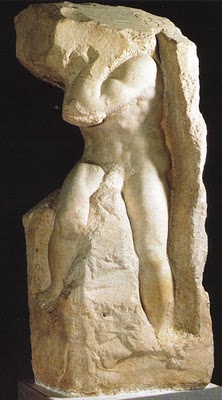In the first of a number of responses to a rather life enhancing exhibition our new resident sculptor in residence Dominic Hopkinson shares his experience of the new exhibition at Yorkshire Sculpture Park
On the first truly lovely evening of the year I found myself standing in the sunshine, glass in hand at the Yorkshire Sculpture Park chatting to a friendly, unassuming Spaniard about alchemy and philosophy. This was all courtesy of Culture Vulture and the good staff at YSP who had arranged a sneak preview of the latest blockbuster sculpture exhibition to arrive in Yorkshire.
Jaume Plensa (pronounced Jowma) is an artist from the Catalan region of Spain, and it was he who was explaining his work to me in terms of ancient alchemical beliefs in the connection between matter, in the form of the human body at death, and the wider Universe. (I was on the orange juice so found that I could keep up with his flights of intellect.) Plensa creates his sculptures from an intricate layering of ideas that includes his love of music, writing and the idea of words existing as objects freed from the page, with what can best be described as an idiosyncratic personal philosophy that sees him meditate on the identity of the individual, the significance of a single thought or idea within the wider cosmos and the politics of human rights and national identity. Whew!
You may have come across Plensa’s work through one piece created in this country in 2009 at the site of Sutton Manors Colliery near St. Helens. Titled “Dream” this enormous elongated head of a child stands 20 metres tall next to a main route into Liverpool, and was a project from the Channel 4 Big Art Project. I have to admit that I didn’t like this work, didn’t see the significance of it for the area and felt it was a fairly blatant attempt to create an “Angel of the North West” (but then Mark Wallinger’s enormous South East White Horse went public and I lost the will to live). I had never come across Plensa’s work before, let alone seen it in the flesh, so I was a little sceptical about what I would find at YSP, and I have to say that I am something of a convert.
Plensa specialises in creating figures, often larger than life castings of his own body image, imprinted or stamped with text references from his muse William Blake (a strange choice for a Spaniard I thought, but a writer and artist that resonates deeply for Plensa) and many other writers, to the names of composers who have significance for him. One of his beliefs is that everything one reads and listens to in life is permanently but invisibly written onto you, to be remembered and recalled. Some of his figures are cast in resin, illuminated from within, some cast in iron. Plensa applies an alchemical take on his chosen materials in the casting process, referring to them as “recuperative materials”. By this I think he refers to the process of change the material undergoes as it moves from a solid, to be melted into a liquid, to be cooled back into a solid, thereby recuperating into its original form but in a new shape.
The other significant way Plensa works is to generate large human forms from letters stamped out of steel and welded together. Some are large enough to generate “rooms” which the audience can enter to experience the work from within; others are just about life size. Here, I have to say, lies the weakest work in the show for me. Without wanting to pun too much, these works strike me as being a bit too literal, and lack the subtlety and depth of his other work.
One of the most striking rooms in the exhibition contains a series of heads carved in the most beautiful alabaster stone. The heads are based on photographs of children from different ethnic groups, which are then digitally elongated and converted into three-dimensional plots, which are then carved into the stone. The effect of entering the room and seeing all the heads facing you is a little disconcerting but you rapidly adjust to the strange appearance of the heads and start to see links across the centuries. Plensa is directly referencing Michelangelo’s series of carvings called “The Captives” or “The Slaves”, which are arguably some of the most important carvings of all time, certainly of the Renaissance. These carvings are unfinished, the limbs and heads emerge from the still visible block with such anatomical accuracy and definition that they make physical Michelangelo’s assertion that he didn’t carve figures; he just set them free from the stone. Plensa’s treatment of his alabaster heads echoes this process, some of the heads being almost totally exposed from the block, others still held cocoon like within the rough block. The intrigue for me was to study the reasoning and choices of Plensa; why he chose to complete one head in that particular block, but not this other one? Why leave behind so much of the original block there and yet use it all up here? Given that these pieces were carved over an extended period the uniformity of form and execution was fantastic. The uniform nature of the heads also echoes the style of his cast work, almost as if he has attempted to make the stone look like a cast material, rather than something carved. I was mightily jealous he had access to such a rare and gorgeous stone, blocks of alabaster that size are found in very few places, and not at all anymore in this country.
The Yorkshire Sculpture Park, with this exhibition, expose the British public to an artist new to these shores, and underline the organisations dedication to broadening the art-form and expanding our exposure to the world’s important artists. It was a real pleasure to hear an artist talk about his work in terms of “beauty” and the “lovely”. It’s not often that contemporary artists admit this as an element of their work, as if the work is somehow less serious, or less important, for it being beautiful. Your reaction to this work can be, and probably will be instinctive; Plensa’s personal outlook will resonate with many people quite easily and naturally. Describing the work as gorgeous, or playful, or friendly, is right up there with any other high falutin’ response.
This is also a rare sculpture exhibition because some of the work you are actually encouraged to touch and interact with, not least the hugely fun gongs in the third room. Rattle the gongs and listen to the murmuring vibration. Hit the gong and feel the deep resonances generated within. Or just bash the living bejeezus out of it, quake to your toenails and hair roots and pretend to be the guy from the Rank films. I just feel sorry for the staff, five months of that cacophony; they’ll need to be issued with earplugs and aspirin.


